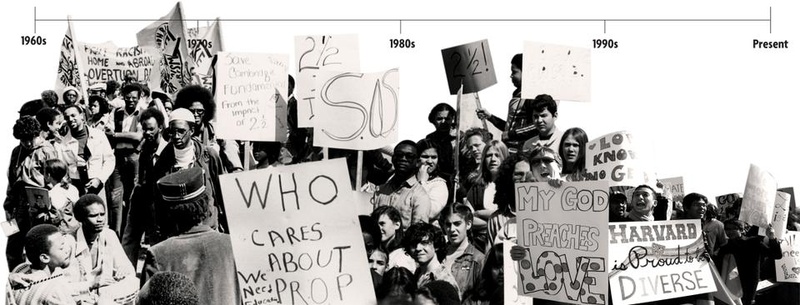The words “fight, fight, fight” chanted during the 1969 protest against Harvard’s Reserve Officers’ Training Corps may share a superficial similarity to “fight the cuts,” a rallying cry during the March for Common Sense this April. But the two protests couldn’t have been more different.
The 1969 rally ended with police clubbing and teargassing the protesters over 300 of whom were arrested, but the other ended with all protesters peacefully returning home after presenting their demands to Mass. Senator John Kerry.
While the concussions and bruises that resulted four decades ago may have been especially brutal even for a period marked by intense student activism, in its own way last month’s rally was an aberration. For a generation raised on a steady diet of Facebook and Twitter, activists are less eager to leave behind their laptops and pick up picket signs, many students say.
This generation of Harvard protesters often puts dialogue before destruction, classes before causes, and private conversation before public confrontation.
The commitment hasn’t abated, students say, but the strategy has changed.
“Today’s Harvard student is a rule follower. They’re at Harvard because they followed the rules. They do well at Harvard because they follow the rules and the rules are to follow the system,” says Michael W. McLean ’12, president of the Harvard Republican Club.
SCHOOLING THE ACTIVIST
In order to start one’s career as a modern activist, a Harvard undergraduate must look no further than the course catalog.
Students this year have spurred the creation of a new secondary field in Innovation for Social Change, an interdisciplinary program that has been sponsored by the School of Engineering and Applied Sciences.
While many of the details are still being worked out, the secondary field will give students the opportunity to explore a range of real world tactics to create social change.
“You get to Harvard and you’re sitting in Tercentenary Theater and President [Drew G.] Faust is telling you how you’re going to change the world, but there’s no real institutional support to motivate further thinking and a deeper analysis,” says Bonnie Cao ’12, vice president of the Undergraduate Council.
A CHANGE IN TACTICS
Even outside the classroom, Harvard activists tend to take incremental steps to further their causes, before adopting more disruptive strategies.
When students first found out about the $650,000 fund to honor former Social Studies Head Tutor Martin “Marty” H. Peretz—who had previously made controversial comments about the Muslim community—they gathered in dorm rooms, not to organize a protest, but rather to draft a letter to the Social Studies department to explain their concerns.
It was only after the department failed to reverse its decision about the fund that students expanded the scope of their efforts with protests in front of the Science Center, putting public pressure on the University, according to Abdelnasser Rashid ’11.
Read more in News
Queer Community Seeks SupportRecommended Articles
-
 Occupy Protests Outside Lamont
Occupy Protests Outside Lamont -
 Protesters Rally Against Library Layoffs
Protesters Rally Against Library Layoffs -
Protesters Hold Second Rally for PilarA group of roughly 30 people protested on Friday afternoon on behalf of Johany Pilar, a mailroom worker who says that she was sexually harassed by a coworker.
-
UC Backs Mental Health RallyUndergraduate Council President Tara Raghuveer ‘14 urged UC representatives to attend a student-organized rally demanding that the administration take action on mental health in an email sent over the Council’s mailing list early Friday morning.
-
 More Than 150 Students Rally for Mental Health Reform
More Than 150 Students Rally for Mental Health Reform -
 HUCTW Holds First Rally in Memorial Church
HUCTW Holds First Rally in Memorial Church














